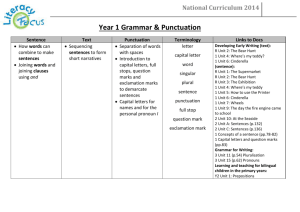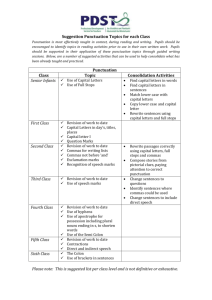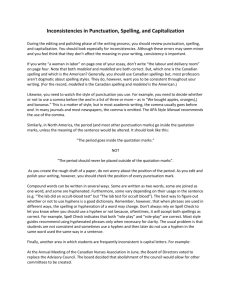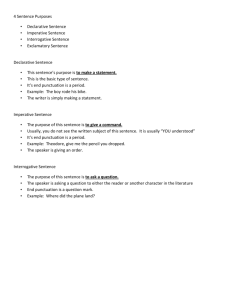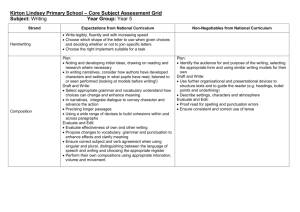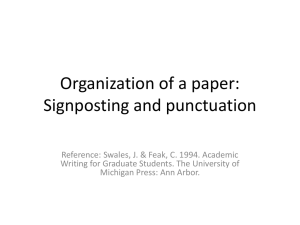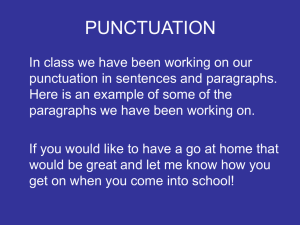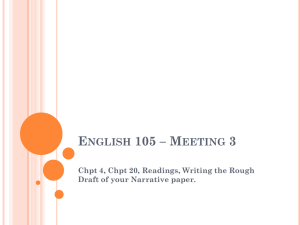1. Introduction
advertisement
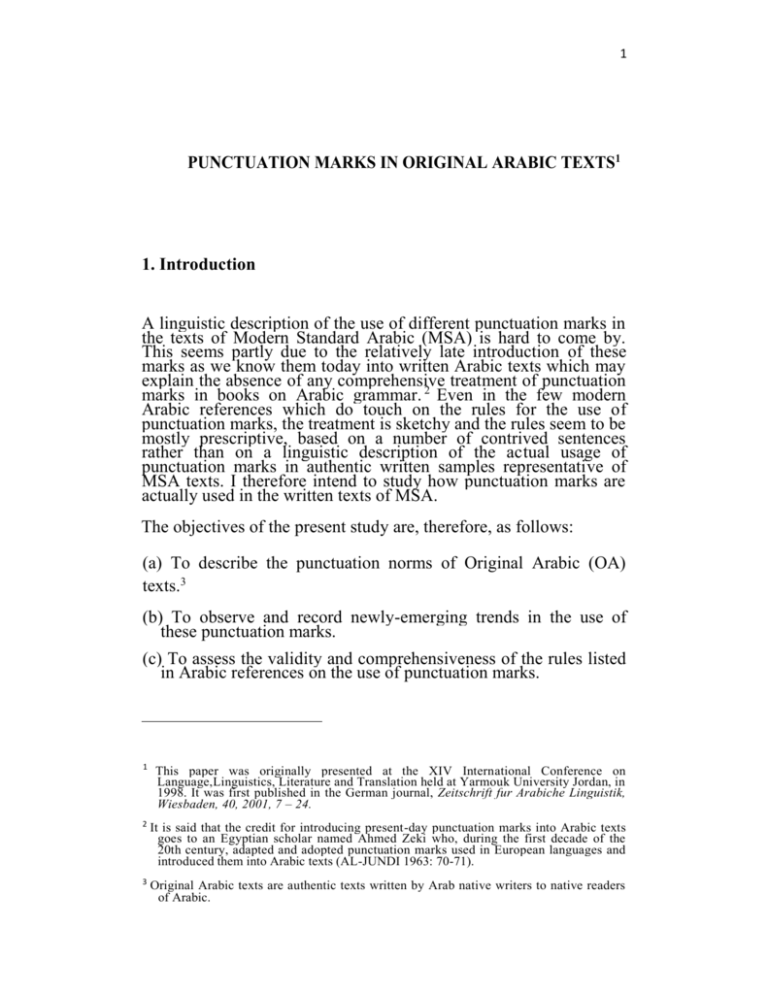
1 PUNCTUATION MARKS IN ORIGINAL ARABIC TEXTS1 1. Introduction A linguistic description of the use of different punctuation marks in the texts of Modern Standard Arabic (MSA) is hard to come by. This seems partly due to the relatively late introduction of these marks as we know them today into written Arabic texts which may explain the absence of any comprehensive treatment of punctuation marks in books on Arabic grammar. 2 Even in the few modern Arabic references which do touch on the rules for the use of punctuation marks, the treatment is sketchy and the rules seem to be mostly prescriptive, based on a number of contrived sentences rather than on a linguistic description of the actual usage of punctuation marks in authentic written samples representative of MSA texts. I therefore intend to study how punctuation marks are actually used in the written texts of MSA. The objectives of the present study are, therefore, as follows: (a) To describe the punctuation norms of Original Arabic (OA) texts.3 (b) To observe and record newly-emerging trends in the use of these punctuation marks. (c) To assess the validity and comprehensiveness of the rules listed in Arabic references on the use of punctuation marks. 1 This paper was originally presented at the XIV International Conference on Language,Linguistics, Literature and Translation held at Yarmouk University Jordan, in 1998. It was first published in the German journal, Zeitschrift fur Arabiche Linguistik, Wiesbaden, 40, 2001, 7 – 24. 2 It is said that the credit for introducing present-day punctuation marks into Arabic texts goes to an Egyptian scholar named Ahmed Zeki who, during the first decade of the 20th century, adapted and adopted punctuation marks used in European languages and introduced them into Arabic texts (AL-JUNDI 1963: 70-71). 3 Original Arabic texts are authentic texts written by Arab native writers to native readers of Arabic. 2 The research corpus is a randomly selected Arabic text which belongs to the literary genre of the short story. This OA text is a short story entitled al-Hafila Tasir 'Bus Walk,' by MAHMOUD ALRIMAWI from Jordan. The corpus also contains a single passage taken from the OA text which covers most of the short story. This passage was depunctuated and presented to ten Arab teachers of Arabic at the university level (henceforth, the ATAs), who were asked to re- punctuate it. I closely examined the use of punctuation marks in the OA text, as well as in the ten different versions of the passage which was re-punctuated by the ATAs. The research procedure used in this study can be summed up in the following steps: (a) Different punctuation marks used by the writer of the OA text were sorted out first. For each punctuation mark, it was noted whether each of the ATAs used the same mark, a different mark, or no mark at all. The aim was to look for instances of correspondence and divergence in the use of punctuation marks by educated Arabs. (b) The agreement of at least half of the ten ATAs with the OA writer, or among themselves, on the use of a particular punctuation mark in a given position was considered to represent a case of correspondence in punctuation usage. Conversely, the disagreement of at least half of the ATAs with the use of a particular mark by the OA writer, and their agreement to use an alternative punctuation mark, was treated as an instance of divergence. (c) Instances of correspondence between the OA writer and the ATAs, or among the ATAs themselves, were taken to represent indicators of the norms of usage agreed upon by educated Arab writers, whereas cases of divergence were interpreted as signs of punctuation variation, instability, and/or newly-emerging trends in Arabic punctuation usage. (d) High correspondance of usage with a given punctuation rule listed in Arabic references was understood to constitute evidence supporting the validity of that rule. On the other hand, a high ratio of divergence was taken to indicate that a given rule is not a true representative of the linguistic facts of punctuation usage, and that it therefore needs either to be rejected or modified. The text analysis which I conducted revealed that the comma and the period constitute about 85% of the total number of punctuation marks found in the corpus. Other punctuation marks were scarcely used. Only four significant instances of correspondance were found in the whole set of data to represent all the uses of the colon, the question mark and the dash together. Likewise, only one instance of significant divergence, involving brackets (parentheses), was found. Such a small 3 number of instances of these punctuation marks would be insufficient to warrant arriving at any reliable conclusions and/or generalizations in a study whose main objective is to find punctuation 'norms,' which can be safely deduced only by detecting as many cases of usage correspondence as possible. It has, therefore, been decided to deal exclusively with the comma and the period as representative of other punctuation marks, and to leave the examination of the uses of the other marks to researchers with larger corpora at their disposal. 2. RESULTS OF THE CONTRASTIVE TEXT ANALYSIS The contrastive text analysis between the OA text and its ten duplicate versions revealed that the ATAs retained only 38% of the total number of the punctuation marks as originally used by the OA writer. This shows the relatively low level of correspondence in the use of punctuation marks between the OA writer and the ten ATAs. The above percentage also raises many relevant questions. Do these abundant cases of disagreement fall within the range of the permissible linguistic variation which is characteristic of normal language usage? If so, what are the rules which govern this wide variation in the use of punctuation marks in Arabic texts? In this variation catered for by the rules on the use of punctuation marks listed in Arabic references? These questions, and many others, are crucial for linguistic research on this yet unexplored territory of punctuation marks and their use conventions in Arabic texts. The present study is but an altempt to tackle some of these questions. Hence, it is important to carefully examine the following findings drawn from the contrastive text analysis of punctuation marks in original Arabic texts. Results of the contrastive text analysis are reported separately below for the comma and the period. This section of the study is therefore divided into two major subsections, each reporting the results of the constrastive text analysis for one of the two punctuation marks as used in the OA text as well as by the ATAs in the ten versions of the OA duplicate passage. This means that the unit of analysis and discussion is a given punctuation mark. The rules of usage listed in Arabic references for each of the two major punctuation marks are listed first in every subsection. These rules are used as a background against which the actual usage of that punctuation mark is checked. The different uses of each mark are then examined as found in all the research data. Exemplary sentences are quoted from the corpus to illustrate specific uses of the given punctuation mark. It is perhaps necessary to point out that for the purposes of the OA text analysis undertaken in the present study, a sentence is defined as the minimum stretch of text which is structurally independent or self-sufficient in a way that would, at 4 the end of it, allow a long pause in speech or a period, a question mark, or an exclamation mark in writing. 4 2.1 THE COMMA Arabic references list many different rules for the use of the comma. It soon becomes clear from these rules that the comma is used in Arabic texts both in-tersententially, viz., to join one sentence to another, as well as intrasententially to set off different components within the same sentence. More specifically, the comma is used, according to the rules in Arabic references, between:5 a) short sentences which are semantically related and which together make up a complete and useful utterance; (b) subordinate adverbial, adjectival phrases/clauses and their main clauses; or conditional (c) items in a series, like days of the week, seasons of the year, etc.; (d) the addressee in a vocative structure and the rest of the sentences; and (e) the two constituents in a structure of apposition. It was found from the text analysis that the comma was the punctuation mark most frequently used both by the OA writer and the ATAs. The comma represented 65% of the total number of all punctuation marks in the OA text. This was followed by the use of the period, which accounted for 20%. The remaining 15% of the punctuation marks was found to be shared by all the other marks used in the data. This high frequency of occurrence of the comma in the OA text should attract the attention of scholars, writers, teachers and learners of Arabic to the importance of the correct use and proper teaching/learning of this punctuation mark. The present paper, accordingly, seeks to give attention to the description of the different uses of the comma found in the corpus, as well as to arrive at an interpretation of the frequent occurrence of the comma in Arabic texts. Out of the 28 commas originally used by the writer of the OA text passage which was presented, in a depunctuated form, to the ten ATAs, the ATAs used 11, 16, 17, 7, 16, 15, 14, 13 and 5 commas, respectively. Thus, the average number of commas used 4 This working definition of the sentence is based on views from modern linguistics as well as from ancient Arab rhetoricians such as al-Jurjani. 5 For a listing of these rules, see MUHAIDAT and BORINI (1989: 68), AL-RAWSAN (1989: 79), AL-SHEJKH (1993: 151) and ABU HALTAM (1988: 66), among others. 5 by the ATAs was 13. This represents a little less than 50% of comma agreement between the writer's and the ATA's uses of the comma in the original Arabic corpus. The above figures also show a wide range of disagreement among the ATAs themselves, with ATA «10 showing only 5 instances of agreement with the OA writer, and ATA «3 having 17 matches. It can be concluded from this that the range of discrepancy in the use of the comma by educated Arabs is wide indeed. But, as the principal objective of the paper is to discover the norms of use, instances of correspondence are to be given priority over those of divergence.6 2.1.1 INSTANCES OF CORRESPONDENCE Table 1 below shows that there are 17 instances in which the OA writer and at least half of the ATAs agreed to use a comma in the same position (positive correspondence). On the other hand, there are 8 instances in which half or more of the ATAs used a comma in the same position where the OA writer used a different punctuation mark (negative correspondence). Table 1: Type, and frequency of comma correspondence7 Frequency 9 7 6 5 Positive Correspondence Negative Correspondence S1, S21, S26 S12, S18 Sl2, S23, S28 S11, S26 S14 S2, S7, S8, Sl0, S14, Sl6, Sl7, S6, S9, S15, S24 S20, S27, S28 The above table shows instances of comma correspondence, both positive and negative. The fact that the same sentence, e.g. Sl2, appears under both positive and negative correspondence means, firstly, that the OA writer has used a comma in this sentence for which at least half of the ATAs also used a comma in the same position. This is a case of positive correspondence. Secondly, it means that the OA writer has used a different punctuation mark elsewhere in the same sentence where half or more of the ATAs used a comma instead (hence, negative correspondence). The figures under 'frequency' show, for example, that nine ATAs used the same comma as the OA writer in S1, compared with five in S2. It also shows that seven ATAs have agreed to use a comma in S28, where the OA writer used a different punctuation mark. All twentyfive instances of comma correspondence given in the above table 6 See Section 1 for the definition of ‘correspondence’ and ‘divergence’. The letter S refers to 'Sentence' and the subscript which follows indicates the sequence of that sentence in the OA text. For determining sentence boundaries, see footnote 5, and related definition on the same page. 7 6 are considered to be representative of agreed-upon usage of the comma in the Arabic punctuation system and are, therefore, examined closely below. Sentences with higher frequencies of agreement are tackled first. A quick overview at the above twenty-five sentences in the OA text shows that the commas in these sentences can be subdivided, according to their position, into (a) sentence-final commas, and (b) sentence-medial commas. Commas in group (b) usually appear within sentences after dependent clauses, whereas those in (a) occur at the end of sentences. Table 2 below shows this positional distribution of the commas: ____ Table 2: Position of comma correspondence Sentence-final Sentence-medial S1, S6, S7, S8, S9, Sl0, S2, Sl2, Sl4, S26, S11, Sl2, S14, SI5, Sl6, Sl7, S26, S28, S28 S18, S20, S21, S23, S24, S27 It thus becomes evident that the single major use of the comma in Arabic is to mark the end of a sentence, a function typically reserved for the period in the English punctuation system. It is to be recalled that the first rule cited from Arabic references in Section 2.1 above states that the comma is used to set off, or join, 'short' sentences which together make up a 'long' utterance. The following are sample sentences from the corpus which demonstrate the above use of the comma in sentence-final positions: (S1) (S20) ، – في المرة األولى كنت أقود سيارتيa ) 1( ، فقد سلموا أمرهم لب كما يبدو، – أما هؤالء الركابb – وانصرفوا يتبادلون فيما بينهم أحاديث صاخبة مفعمة بالرضا والفضولc (S21) ،والمرح Nine ATAs agreed with the OA writer on using a sentence-final comma in each of the above sentences. Similarly, seven ATAs, together with the OA writer, concluded the following sentence with a comma: (S18) ،َ ) إال أن المفاجأة تمثلت في احتجاب الرؤية كليا2 ( 7 Seven ATAs, however, used a sentence-final comma to end the following two sentences whereas the OA writer has used a period to terminate both sentences: كحال، – ولم يكن هناك سوى مقاعد قليلة متناثرة ومساحات فسيحة خاليةa ) 3 ( ،الحافالت التي تستخدمها المطارات لنقل الركاب بين صالة المطار والطائرة (S12) ]…[ ربما ألعتقادهم أن الحافالت عندنا هي على هذه الشاكلة أو لثقتهم في8 – b (S23) ،براعة قيادتي It is to be noted that the six sentences in (1), (2) and (3) above vary in their length. The number of words in them ranges between six words in (l.a) to twenty-one in (3.a). Therefore, the reference to the use of the comma in Rule (a) in Section 2.1 after 'short' sentences is either unfounded or, at least, fuzzy. Yet, the fact that the OA writer, together with three ATAs, chose to conclude the 21-word sentence in (3.a) above by a period, rather than a comma, seems to suggest that there is a growing tendency in Arabic to terminate single, but long, sentences, with a period. The above conclusion gains more credence when we look at the following sentence, for example, with respect to which the subjects were divided whether to use a sentence-terminal comma or a period: ) ومع ذلك فما ان اعتليت كرسي القيادة حتى تمكنت على الفور من تشغيل الموتور4 ( (S16) واألنطالق بالحافلة على الطريق المستقيم الذي أعرفه من قبل The above sentence is fairly long. In (4), the OA writer, as well as five ATAs, used a sentence-final comma whereas the other five ATAs used a terminal comma. We now move to examine sentences in the data where a comma is used medially to set off either (a) a main clause from a subordinate clause, or (b) a main clause from a fragment, viz., a phrase. A quick look at Table 2 above shows that there were seven sentences showing correspondence with instances of such commas in the corpus. Let us examine these medial commas in more detail, starting 8 Three dots within square brackets represent my deletion of irrelevant elements in OA sentences when quoted as examples. 8 with instances of correspondence and moving on to those of divergence. All four sentences below consist of main clauses preceded or followed by subordinate clauses: ولما لم أكن قادراَ على متابعة، – ولما لم يكن أحد سواي مدركا َ لجسامة الخطرa ) 5 ( (S26) فقد قررت أن أترجل،أداء هذه المهمة المستحيلة وهي القيادة دون رؤية كحال، – ولم يكن هناك سوى مقاعد قليلة متناثرة ومساحات فسيحة خاليةb (S12) الحافالت التي تستخدمها المطارات لنقل الركاب بين صالة المطار والطائرة فيما حقائبهم ملقاة كيفما اتفق هنا وهناك، – لكن الهرج والمرج كان يسودهمc (S14) وكأطول ما تكون عليه هذه الحافالت، – ]…[ كنت أقود حافلة فارهة عريضةd (S2) الحديثة In (5.a) above, nine ATAs agreed with the OA text writer on using the first medial comma and six ATAs on the second. Seven, six, and five ATAs agreed with the writer on the use of the medial comma in (5.b), (5.c), and (5.d), respectively. It thus seems that one of the standard uses of the comma in Arabic is to set off a subordinate clause from its main clause. This use is indeed listed in all Arabic references on punctuation marks cited in the bibliography (see ALRASAN 1989: 23, MAHAIDAT and BORINI 1989: 68, ABU AJMIYA 1998: 66; among others). There are many other instances in the corpus, however, which seem to run counter to the above rule and conclusion, as will be argued in section 2.1.2 below. Finally, it remains to say a word on medial commas which are not used to separate two clauses as in the above sentences. In the following sentence: (S28) […] الى شارع ترابي، ) ]…[ فقد قفزت بلمح البصر الى الخارج6 ( the OA writer used a medial comma to separate the noun phrase الى الخارجand الى شارع ترابيwhere the two NPs stand in apposition to each other. Half of the ATAs also used a comma, like the OA writer in the above sentences but the other half did not. The use of a comma to mark the boundary of the appositive relation thus seems only optional. Many Arabic references list this function of the comma among its standard uses in Arabic texts (see AL-RAWSAN 1989: 23, MUHAIDAT and AL-BORINI: 1989: 68; among others). However, the rules do not seem to account for this 'optionality' in the use of the comma. Such rules are, therefore, in need of modification. 9 2.1.2 INSTANCES OF DIVERGENCE Before concluding this discussion on the different uses of the comma in the sample data, it may be worthwhile to look quickly at instances of divergence where the OA writer has used a comma, but at least half of the ATAs used a different punctuation mark instead. The following table shows these instances of divergence: Table 3: Frequency of comma divergence9 Frequency 9 7 6 5 Sentences with of Divergence S20 Instances SS, Sl3 S28 S2, Sl0, Sll, Sl6 Examining the above instances of comma divergence may, as was said earlier, shed light on areas of high punctuation variation and/or new punctuation tendencies in Arabic. A quick look at the actual sentences listed in Table 3 above will reveal that in four out of the eight sentences, the OA writer's commas were replaced with zero punctuation marks by the ATAs, including those which appear with the highest frequencies in Table 3. The highest frequency of divergence is found in (S20) below: (S20) فقد سلموا أمرهم لي كما يبدو، ) أما هؤالء الركاب7 ( Nine out of the ATAs used a zero punctuation mark instead of the comma used by the OA writer. This is a strong indication that a comma is not commonly used in Arabic to set off subordinate phrasal elements in sentences despite what the 'prescriptive1 rules on Arabic punctuation claim. (See AL-RAWSAN 1989: 23, MUHAIDAT et al. 1989: 68, and ABU AJMIYA 1998: 66, among others) Likewise, five ATAs used no punctuation mark in the place of the two commas in the following sentence: 9 The fact that some sentences like S20, for example, appear both in this table as well as in Table 1 earlier, means that the OA writer has used two commas in such sentences and that one of the two represents a case of 'correspondence' while the other represents a case of 'divergence' . 10 (S2) […] كنت أقود حافلة عريضة، بعد أسبوعين على األولى، ) في المرة الثانية8 ( Only one ATA used two commas as the OA writer had, while four used two dashes instead of the commas. Rules on punctuation usage in Arabic references do not, in fact, list this use of the comma. Rather, they state that double dashes are used to set off parenthetical sentence elements in Arabic texts (see AL-SHEIKH 1993: 156, AL-RAWSAN 1989: 25, and ABU-HALTAM 1988: 67, among others). The fact that five ATAs agreed not to use any punctuation marks around the parenthetical phrase بعد اسبوعين على األقلshows that the above rule concerning the punctuation of parenthetical elements needs to be modified so as to accommodate such punctuation facts as the above. Moreover, the use of double commas, by the OA writer and one ATA, to mark off the parenthetical phrase in (82) seems to reflect a growing tendency in Arabic texts. This is probably due to the influence of punctuation norms in European languages, especially English, where setting off parenthetical sentence elements is one of the standard uses of double commas. 10 The above conclusion concerning parenthetical sentence elements gains more credence from the following two sentences: – على أني فوجئت منذ البدء وقد صعد الركاب قبلي أن كرسي القيادةa ) 9 ( (S10) […] [ الكرسي ( ومعه المقود طبعا ً ) وياللغرابة يقع في منتصف اsic] – إذ أن هذهb (S11) َ لحفلة تقريبا In (9,a) above, five ATAs used double dashes to set off the parenthetical clause, وقد صعد الركاب قبليwhile two used commas. Similarly, in (9.b), five ATAs used double dashes around the parenthetical phrase وياللغرابةwhereas two ATAs used commas. 2.2 THE PERIOD Arabic references explain that the period represents a long pause in speech, longer than that of the comma. Its main uses, according to these references, are to:11 10 See, for example, the Guide to Punctuation in: Webster's New World Dictionary (New College Edition 1993: 1680). 11 See, among others, ABU AJMIA 1998: 98, AL-KHULI 1988: 169, AL-SHEIKH 199ABU HALTAM 1998: 65, and MUHAIDAT et al. 1989: 69. 11 (a) Conclude a sentences which is 'complete' and 'independent'. (b) Terminate an 'utterance' so as to signal its completion. (c) Signal the end of a paragraph. It seems from comparing the above uses with those previously cited for the uses of the comma that the only clearly exclusive use of the period is given in Rule (c) above, viz., to ‘signal the end of a paragraph’. According to the same Arabic references, a comma can replace the period in both (a) and (b) above. The use of a period or a comma in these rules seems to depend on the relative length of sentences. Commas are to be used to separate ‘short’ sentences, whereas periods are to terminate longer ‘complete’ and ‘independent’ sentences. But, how short is a ‘short’ sentence and how long is an ‘utterance’? And, what is a ‘complete’ and ‘independent’ sentence? Thus, the distinction between the use of the period and that of the comma, according to rules like those above, seems fuzzy, at least as far as their use at the end of sentences is concerned. To investigate the matter further, let us examine how the period is actually used in Arabic texts both by the OA text writer and the ATAs. The OA writer has used the period only nine times in the 29sentence passage given to the ten ATAs for repunctuation. Similarly, the ATA’ s use of the period in the same positions as the OA writer was low; it ranged from five periods by one of the ATAs to only one period by another. The above figures on the frequency of use of the period in the analyzed OA texts reflect the marginal status of the period in Arabic texts as well as the wide range of discrepancy among native writers of Arabic. Below is a quick survey of the nine positions at which the OA writer used a period and how these positions were repunctuated by the ATAs. The following table shows the instances of correspondence (positive and negative) in the use of the period in the analyzed text passage as well as their respective frequencies: Table 4: Instances of period correspondence and their frequency Frequency Positive Correspondence 7 S25, S28 5 4 S9 Negative Correspondence S5 S16 S2, S7, S19, S27 Table 4 above shows that only in two sentences did more than five ATAs use the same period as the OA writer, viz., S25 and S28. These are, as was explained in the comma section earlier, instances which represent positive correspondence. Besides, four ATAs agreed with the OA writer in S9. Because both the sample of the data and the use of the period are limited, we will also include, in 12 our discussion these four instances of frequency correspondence. On the other hand, we will also examine cases of negative correspondence in positions where a significant number of ATAs agreed to use the period despite the fact that the OA writer has used a different mark. The frequency of correspondence in these instances also ranges from seven in S5 to four in S2, S7, Sl9, and S27 respectively, as shown in Table 4. On the other hand, Table 5 below reports instances of divergence, where the OA writer used a period while a significant number of ATAs agreed on using another punctuation mark: Table 5: Instances of period divergence and their frequency Frequency 7 6 5 Representative Sentences Sl2, S23 S14 S9, SIS, S24 As the above table shows, there are six cases in which the frequency of divergence ranges from five to seven. 2.2.1 INSTANCES OF PERIOD CORRESPONDENCE As was just mentioned above, a fairly significant number of ATAs agreed on the use of the period in the nine cases specified in Table 4. Three of these cases of correspondence, both positive and negative, are of special importance since they involve the vast majority of the ATAs. It is to be remembered that in our search for punctuation norms, we are more interested in instances of correspondence, and especially in those of high frequency. Hence, let us examine S2S, S28, and S5 first, since in each of them seven ATAs were in agreement on using a period in the same positions as the text passage. In both S25 and S28 below, seven ATAs have used a period in the same position as has the OA text writer: 13 – ]…[ ان العجالت الضخمة للحافلة أخذت تطحن أجساما َ ما فيa ) 11 ( (S25) .طريقها – حيث استيقظت ألجدني متيبس األطراف مخطوف األنفاس ودقاتb (S28) .قلبي تتسارع بصوت مسموع The vast agreement among Arab writers on the use of a period to conclude sentences like the two above is worthy of special attention, since it seems to spotlight a candidate for a punctuation norm in Arabic texts in relation to the use of the period. This high ratio of correspondence is especially important since, as was pointed out above when commenting on the rules on the period cited in Arabic references, it is more common to join full sentences in Arabic texts with a comma than to set them off by a period. So, how can we account for the agreement of the seven ATAs with the OA writer on the use of sentence-final periods in (10. a) and (10. b) above? A quick look at all the OA text passage is sufficient to suggest an answer to the above question. Both sentences above arc located at the very end of the respective paragraphs in which they occur. Hence, it can be safely concluded that one of the standard uses of the period in Arabic texts is to conclude sentences which appear in paragraph-final positions. As was said above in Section 2.2, it is to be remembered that this is the only exclusive use of the period among the three rules on its use listed in Arabic references. The other two uses of the period, as we have pointed out, are shared with the comma as can be seen from a quick comparison with the rules listed in Section 2.1 above. Consequently, Rule (c) in Section 2.2 above can be said to be verified by evidence drawn from the actual use of the period in the OA text. In (Ss), which is reproduced in (11) below, seven ATAs have also agreed on the use of a period where the OA text writer used a comma: (S5) . ) نحن ضيوف وال سائق لهذه الحافلة المخصصة لنا11 ( The period in the above sentence is sentence-final, but the sentence it terminates docs not conclude a paragraph. So, how can we explain the large agreement among the ATAs? The OA writer, along with three ATAs, used a comma. This use of the comma is normal according to the rules in Section 2.1 cited earlier. However, the fact that seven out of ten ATAs have alternatively used a period rather than a comma to terminate Ss in (11) above reflects a noteworthy consensus. Is there anything which is especially characteristic of this particular sentence? This question becomes more relevant when we notice that all seven ATAs have in fact used commas to conclude other sentences which occur earlier than this sentence in the passage, but have chosen to terminate (Ss) with 14 a period instead. It seems worthwhile to note that (Ss) is the final sentence in a series of three sentences which make up an utterance, viz. a semantic chunk in a given discourse or text, as can be seen from (12) below: نحن ضيوف، نريد منك هذه الخدمة. . . ) أحدهم قال لي ]…[ هل ستقودها12 ( (S3 , S4, S5) وال سائق لهذه الحافلة المخصصة لنا The sentence in (13) below, which directly follows (Ss) in (12) above in the OA text, indicates a shift in the flow of the text and the beginning of a new semantic unit: (S6) لم ال ؟: ) ودون أن أفحص األمر قلت دون تردد13 ( The use of a period rather than a comma to conclude the last sentence in a series of coordinate sentences which are complementary in a textual semantic chunk seems to represent another punctuation norm of the period. It is noteworthy that this use of the period is listed in most Arabic references, as can be seen from Rule (b) in Section 2.2 above. This also seems to apply to the punctuation of (S9) below, which is shown under the heading of positive correspondence in Table 4. (S9) . ) وبودي حقا َ أن أخوض التجربة لمجرد خوضها14 ( In the above sentence, five informants, including the OA writer together with four ATAs, used a sentence-final period. It is to be noticed that (S9) above is a short sentence. Such sentences are normally not granted the status of orthographic independence and arc consequently not terminated with periods. This seems to explain why the other five ATAs used a sentence-final comma rather than a period. Yet, similar to (S5) in (11) above, (S9) comes as the last sentence in a series of seven short sentences which together make up one long 'major' sentence which realizes a discoursal semantic unit within the text. As was just said above, the rules allow for this use of the period. Yet, these rules do not. seem to account for the alternative use of a comma as represented by the usage of the five ATAs just referred to above. In (S16) below, five ATAs agreed on using a sentence -final period, while the other five together with the OA writer have used a sentence-final comma instead .This can be seen from Table 4 in the column of negative correspondence: ) ومع ذلك فما أن إعتليت كرسي القيادة حتى تمكنت على الفور من تشغيل15 ( (S16) الموتور واألنطالق على الطريق المستقيم الذي أعرفه من قبل 15 It is to be noticed that the sentence above is fairly 'long'. As was already me-tioned earlier in Section 2.1.1 when discussing this sentence together with other similarly long sentences, there is a powerful, growing tendency to use periods to terminate such sentences in Arabic. The alternative punctuation of this sentence also shows that native writers are divided over whether to use a comma or period to terminate such 'long' sentences in Arabic. The punctuation of even the same writer may vary when dealing with such sentences. While the OA writer used a comma to terminate S16 in (15) above, he opted to conclude the similarly long sentence of (S12) in (3) earlier with a period. Finally, Table 4 above also shows that in each of the following four sentences, four ATAs chose to use a sentence-final period while the OA writer has used a comma: ، كنت أقود حافلة فارهة عريضة، بعد اسبوعين على األولى، – في المرة الثانيةa ) 16 ( (S2) وكأطول ما تكون عليه الحافالت الحديثة كنت كعادتي ال أستطيع رد طلب بوسعي تلبيته ألحد- b – فأخذت أقود ببطء آمالَ أن تتجنب السيارات حافلتنا التي تقل غرباء كما هوc (S19) َ الحال دائما (S7) –]…[ لم يكن هناك ما يلزمني بمثل هذه التضحية التي ستؤدي بي وبالركابd (S27) َ معا It may be worthwhile to examine these four sentences in an attempt to understand the reasons behind the agreement among the four ATAs and their disagreement with the OA writer. It is to be noted that (S2), (Sl9), and (S27) above are fairly long sentences. This, as was pointed out earlier, may explain why four ATAs have chosen to give each an independent orthographic status by marking each with a sentence-final period. A shorter sentence is not normally given this status in Arabic texts. This is evident, for example, in the punctuation of (S1) in (17) below which directly precedes (S2) just quoted in (16). (S1) ، ) في المرة األولى كنت أقود سيارتي17 ( Nine ATAs, together with the OA writer, agreed on using a concluding comma. It thus becomes clear that the use of a period to terminate fairly long sentences is gaining currency in Arabic. Shorter sentences, however, like (S1) above and (S7) in (16), are still terminated by commas in the vast majority of cases. Nevertheless, the fact that four ATAs used a period to conclude (S7) above is indicative of a modern tendency by Arab writers, probably 16 under the influence of English punctuation, to use periods to terminate even short sentences. 2.2.2 INSTANCES OF DIVERGENCE It remains now to have a quick look at the cases where the OA writer himself uses a period, but at least half of the ATAs do not do so. Out of the nine sentences where the OA writer uses a sentencefinal period, the ATAs disagreed with him in six of them, as shown in Table 5 above. Although these six cases were already discussed earlier in the comma section, it would still be worthwhile to briefly examine them here in relation to the period. It may be useful to try to answer the negative question: Why did a significant number of ATAs not use a sentence- final period in these sentences while the OA writer has done so? Seven ATAs used commas instead of the periods used by the OA writer at the end of (Sl2) and (S23) below, six did so in (Sl4), whereas five did so in (S9), (S15) and (S24): كحال الحافالت، – لم يكن هناك سوى مقاعد قليلة متناثرة ومساحات فسيحة خاليةa ) 18 ( (S12) التي تستخدمها المطارات لنقل الركاب بين صالة المطار والطائرة – ]…[ ألعتقادهم أن الحافالت عندنا هي على هذه الشاكلة أو لثقتهم في براعةb (S23) قيادتي فيما حقائبهم ملقاة كيفما اتفق هنا وهناك، – لكن الهرج والمرج كان يسودهمc (S14) (S9) – وبودي حقا َ أن أخوض التجربة لمجرد خوضهاd (S15) (S24) – وقد أثارني وقوفهم وتنقلهم من مكان آلخرe – لكن قلقي سرعان ما أخذ ينمو ويتفاقمf Sentences (18. a), (18.b) and (18. c) above are fairly long sentences and, on the basis of length alone, could have been concluded by periods. However, all three sentences bear a close sentence link to the sentences directly following them in the OA passage. Sentence (10. a), for example, is directly followed by (Sl3) below, which clearly belongs to the same discoursal semantic chunk as (10. a): (S13) َ ) ولم يكن عدد الركاب كيرا19 ( This seems to have prompted the ATAs to use a comma rather than a period to join the two sentences in each case. Thus, it is not 17 the ‘length’ of sentences alone which justifies concluding a sentence with a period. The other three sentences, viz., (10.d, e, f) in (18) above are all short sentences and are more likely to be terminated by commas in light of the rules on comma usage in Arabic texts. Nevertheless, the fact that the OA writer and some ATAs marked them with sentence-final periods reflects the abovementioned fledgling tendency to end even short sentences with terminal periods. It is noteworthy, however, that such cases are not high on the scale of frequency in the ATAs* usage, as shown in Table 5. 3. CONCLUSIONS AND SUGGESTIONS The following conclusions have been drawn from the contrastive punctuation analysis of original Arabic texts conducted in the present study. 3.1 CONCLUSIONS ON THE COMMA (a) The comma was found to be the most profusely used punctuation mark in Arabic texts. In general, its frequency of occurrence amounts to about 65% of the total number of all punctuation marks used. (b) There is a wide discrepancy in the frequency with which the comma is used among educated Arabs, as can be seen from Tables 1 and 3 above. (c) The main use of the comma is to set off the boundary between one sentence and another in a chain of related sentences. This inter-sentential function was found to be the most common (see Table 2). This use is referred to in the punctuation rules cited in Arabic references (see Section 2.1), but the present study has detected many counter-examples in the data. A strong growing tendency has been observed, for example, to punctuate sentences, especially 'long' ones, with sentence-final periods rather than commas, as can be seen from sentences reproduced in (4) above. (d) The comma is also used in Arabic intra-sententially, viz., to separate phrasal/clausal sentence elements from the main clauses in sentences. Initial or terminal subordinate clauses, for example, are set off by commas from their main clauses, as seen in (5) above. Although this use of the comma is listed in most Arabic references, the text analysis revealed that this 'rule' is not always applicable, as was pointed out in Section (2.1.2). Commas were also found to be used medially to set off parenthetical sentence elements, as can be seen from (8) above. This use is not listed among the uses of the comma found in Arabic references on punctuation. (e) The comma is also used in the data to separate two NPs in appositions to each other, as seen in (6). This is one of the 18 recognized uses of the comma according to Arabic references mentioned in Section 2.1, Yet, this use of the comma was not adhered to in many instances found in the corpus, as seen in (6) above. (f) Despite the rules cited earlier in Section 2.1, the uses of the comma listed above in (c), (d) and (e) have been found to be optional. Many ATAs, as well as the OA writer have cither used no punctuation mark in such positions or opted for punctuation marks other than the comma. 3.2 CONCLUSIONS ON THE PERIOD An examination of how the period is used in the OA corpus of the present study has yielded the following conclusions: (a) The period is the second most frequent punctuation mark used in the OA corpus. It constitutes 20% of the total number of punctuation marks, compared to 65% assumed by the comma and 15% by all other punctuation marks. (b) The frequency of correspondence in the use of the period (see Section 1, for definition) is very low, whether between the ATAs and the OA text writer, or among the ATAs themselves (see Tables 4 and 5 above). (c) The only agreed-upon use of the period is to conclude sentences which occur in paragraph-final positions, as can be seen from sentences quoted in (10) above. This use is listed among the uses of the period in Arabic references (see Section 2.2 above). However, this is the only exclusive use of the period, since the other uses are all shared between the period and the comma in Arabic. (d) There was also considerable agreement among the informants on the use of the period to conclude the last sentence in a series of sentences which together make up a unitary semantic chunk in the discourse of a given text, as can be seen, for example, in (11) and (12) above. This use of the period is listed in the rules found in the Arabic references cited in Section 2.2 above. Yet, it was revealed by the contrastive punctuation analysis that this use of the period, though common, is only optional since a comma has been alternatively used by some informants, as can be seen from ihe punctuation of (14) above. (e) There is a growing tendency to use sentence-final periods in the punctuation of single sentences, especially long ones, as in (15) and (16) above. Although this use of the period is listed in Arabic references, as seen from Section 2.2, it is the comma, rather than the period, which is most frequently used in practice to terminate single sentences in OA texts. Therefore, the above use of the 19 period to conclude single sentences is but a growing trend which is gradually gaining ground in Arabic punctuation usage. 3.3 GENERAL CONCLUDING REMARKS (a) Punctuation usage in original Arabic texts is characterized by a great deal of fluidity. The size of discrepancy and degree of variation among educated native Arabs are high, and punctuation norms are not yet deep-rooted. (b) Punctuation rules listed in modern Arabic references tend to be too general and largely prescriptive, as can be seen from (7) and (11), for example. These rules seem to set standards which have not been validated by actual usage. Besides, they do not generally distinguish between the 'obligatory' and the 'optional' uses of punctuation marks, as seen from (6) above. Consequently, these rules are in need of revision and modification (see example # 8). (c) Punctuation ‘standards’ in Arabic are in a state of Dux, and various fledgling punctuation tendencies are underway. These tendencies constitute potential punctuation norms in the future. Examples of such new trends are the use of parenthetical commas in (9) above, as well as of sentence-final periods in (15), (17) and (18). 3.4 SUGGESTIONS FOR FURTHER RESEARCH It is suggested here that analyses be done of larger corpora of original Arabic texts which provide sufficient data on the use of punctuation marks other than just the comma and the period. Besides, various genres and types of texts, including nonliterary ones, could be examined for punctuation marks in original Arabic texts. 20 REFERENCES - ABU AJMIIYA, M. 1998. al-lugha al-‘arabiyya (The Arabic Language). Amman, Jordan: Dar al-Hilal. - ABU HALTAM, N. 1988. al-murshid fil il-imla:? (A Guide to Dictation). Doha, Qatar: Dar al-Taqafa. - ABU HAMDA, M. 1994.fann il-kita:ba wal-ta‘bi:r (The Art of Writing and Expression). Jordan: Al-Aqsa Bookshop. - AL-AWNI, A. 1997. "muqa:raba ta:ri:ķhiya li ‘ala:ma:t al-tarqi:m". (A Historical Approach to Punctuation Marks). 'Ālam il-Fikr 26 (2), 265-318. - AL-JUNDI, A. 1963. (Ahmed Zeki). Cairo: The General Egyptian Establishment for Writing, Translation, and Publication. - AL-KHUU, F. 1988. dalī:l ila-limla:? wa qawa:‘id al-kita:ba al-‘arabiyya (Guide to Dictation and Rules of Arabic Writing). Cairo: Wahba hookshop. - AL-RAWSAN, S. 1989, asa:siyya:t ft ta‘li:m maba:di? al-?imla:? wal tarqi:m (Fundamentals of Teaching Principles of Dictation and Punctuation). - AL" (Bus Walk). In: muķhta:ra:t min alal-qa ra fi: al-urdun (Selected Short Stories in Jordan). Amman: Ministry of Culture. - AL-SHEIKH, A. 1993. qua:wā‘id al-kita:ba al-‘arabiyya wal insha:? (Rules of Arabic Writing and Composition). - CRYSTAL, D. (ed.) 1995. "Punctuation", The Cambridge Encyclopedia of the English Language. Cambridge: The University Press. - IBRAHIM, A. (?) alimla:? wal-tarqi:m (Dictation and Punctuation). Cairo: Ghareeb Bookshop. - MUHAIDAT, M. and Z. Borini. 1989. al-ba Simple Guide to Arabic). Irbid, Jordan: Dar al-Kindi. -‘arabiyya (The - QASSIM, A. 1989. qawa:‘id il-kita:ba al-‘arabiyya (Rules of Arabic Writing). Kuwait: Al-Falah Bookshop. - Webster's New World Dictionary, 1993. "Guide to Punctuation, Mechanics, and Manuscript Form", 1680-1683. New York: Simon and Schuster.

